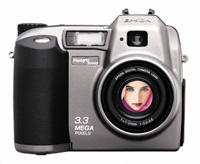Epson Stylus Photo 820
You Can Not Afford Not To
One constant with the past in this new digital world of photography is that it isn't quite a photograph until you have an image printed on paper in hand. The new Epson Stylus Photo 820 answers that need by offering the best in print quality at a price few can refuse. At an announced price of $149, it's a bargain for a six color photo printer. Figure in the factory rebate of $50 and the total purchase cost is just $99. Price, however, is not the only incentive for choosing this new Epson Photo model printer. The 820 also supports Epson's Print Image Matching (PIM) technology, which is enabled by a very effective Film Factory software application bundled with the printer. In addition to Epson's own Photo PC 3100Z 3 plus megapixel digital camera, which I used to test PIM, 12 other digital camera manufacturers have signed on to provide PIM technology in their new model cameras, many of which are currently being sold. To obtain the full, up-to-date list go to: www.printimagemaking.com. |
||||
New Printer Design This newest Epson Photo printer features all of the specifications established as the highest standard for printing photographic images, including a 4 picoliter MicroPiezo print head and 2880x720dpi print resolution, supporting full borderless printing on standard photo-size paper (4x6, 5x7, 8x10). In addition, compared to the previous Epson Stylus Photo 780 model, this new 820 is significantly faster, outputting a 4x6" print in just 48 sec. |
||||
Printing With The 820 Next I made a selection of images from my files of scans from both slides and color negatives, as well as a few gray scale (black and white) images. The subjects were chosen to test the limits in saturation, color balance, and tone range of the printer. I was curious if there were limits or exceptions to the 820's ability to reproduce a wide variety of image characteristics. In addition, I used the Epson Stylus Photo 820 for a lot of mundane daily chores, like printing out proof sheet pages, text documents, and proofs of newly made scans. |
||||
From the outset--installing the printer and its software, making quick, lower resolution prints, setting the driver to maximum resolution, and using automatic, manual, and Colorsync/ICM image adjustment settings--the printer functioned easily, consistently, and reliably. Whether used for office document printing or as a photo printer, there was no sacrifice in either function. And, regardless of the kind of media printed on, from plain paper to Premium Glossy Photo paper, print quality appropriate to the function was uniform, as was printing efficiency and speed. Evaluation & Recommendation If by now you are thinking my description of the Epson Stylus Photo 820 is too glowing to be true, there is at least one very noticeable downside. Compared to other Epson Photo model printers, the 820 is noisy, and not just a little louder than a 1280, my old 1270, an 1160, or a 2000P. It makes more auditory fuss than any of these. And, although faster than the 780 model it replaces, the Stylus Photo 820 is no match in printing speed compared to Epson's 1280/890 premium Photo printers. However, if you have a computer, and want to print both photos and documents, the Epson Stylus Photo 820 leaves few excuses not to enjoy photographs reproduced with the greater quality of a six color printer. For more information, call (800) 463-7766, or visit their web site at www.epson.com. |
||||
Epson Photo PC 3100Z Digital
Camera |
||||
In addition, the Photo PC 3100Z has a built-in microphone and speaker, as well as the ability to capture video clips. A hot shoe on top of the camera offers sync connection for either an attached auxiliary flash or a PC adapter to use external electronic flash with manual aperture and shutter speed settings. A self-timer is included with an activation button, the third one on the top of the camera. The sensitivity is also adjustable providing the equivalent of ISO 100, 200, and 400 speeds. Connection to a computer is by USB, and the camera comes bundled with software supporting both the Microsoft Windows and Apple Macintosh operating systems, including Epson Photo File Converter, Image Expert and panorama stitching applications. The camera is a compact 4.25x3.5x2.56", weighs just 3/4 of a pound, and has a list price of $599. |
- Log in or register to post comments









































